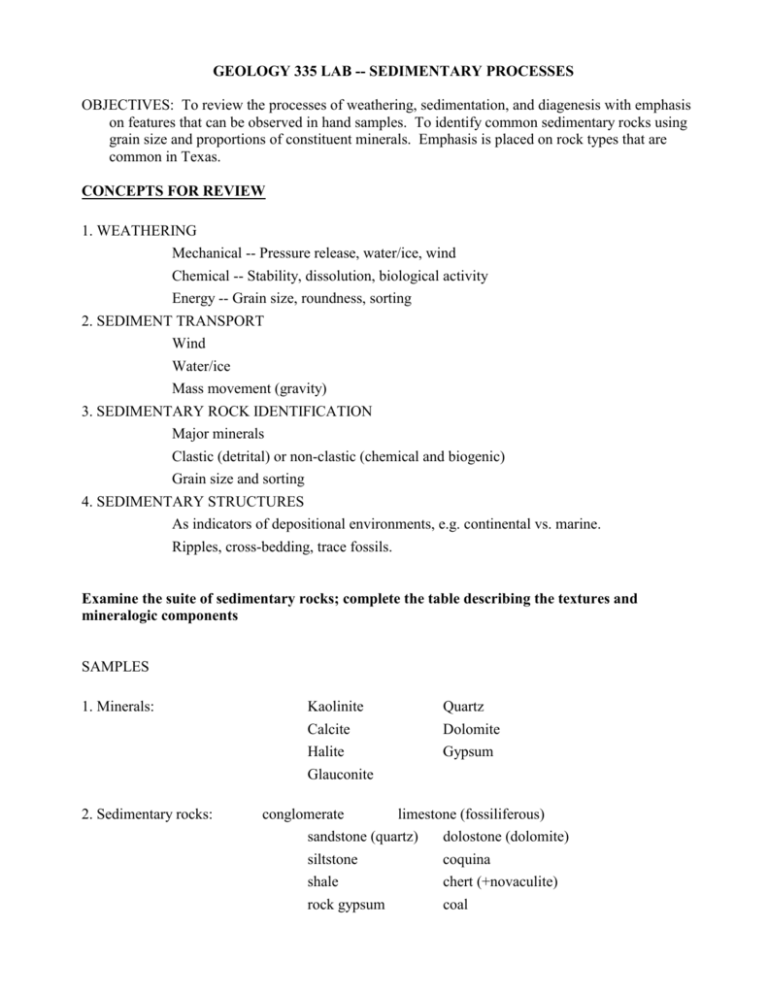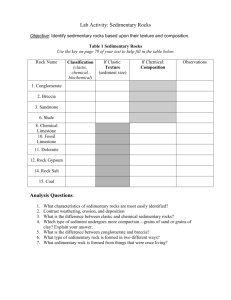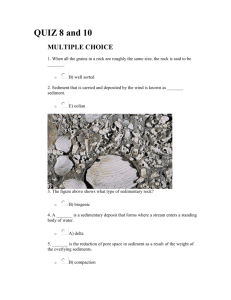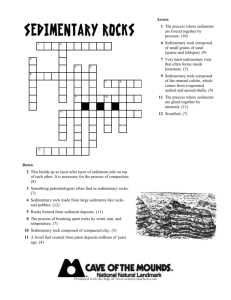GEOLOGY 335 LAB -- SEDIMENTARY PROCESSES
advertisement

GEOLOGY 335 LAB -- SEDIMENTARY PROCESSES OBJECTIVES: To review the processes of weathering, sedimentation, and diagenesis with emphasis on features that can be observed in hand samples. To identify common sedimentary rocks using grain size and proportions of constituent minerals. Emphasis is placed on rock types that are common in Texas. CONCEPTS FOR REVIEW 1. WEATHERING Mechanical -- Pressure release, water/ice, wind Chemical -- Stability, dissolution, biological activity Energy -- Grain size, roundness, sorting 2. SEDIMENT TRANSPORT Wind Water/ice Mass movement (gravity) 3. SEDIMENTARY ROCK IDENTIFICATION Major minerals Clastic (detrital) or non-clastic (chemical and biogenic) Grain size and sorting 4. SEDIMENTARY STRUCTURES As indicators of depositional environments, e.g. continental vs. marine. Ripples, cross-bedding, trace fossils. Examine the suite of sedimentary rocks; complete the table describing the textures and mineralogic components SAMPLES 1. Minerals: 2. Sedimentary rocks: Kaolinite Calcite Quartz Dolomite Halite Glauconite Gypsum conglomerate limestone (fossiliferous) sandstone (quartz) dolostone (dolomite) siltstone coquina shale chert (+novaculite) rock gypsum coal Front table should have large samples of above plus structures. TABLE -- COMMON SEDIMENTARY ROCKS Rock Type Characteristics Limestone May be composed of shell fragments or calcareous sand (i.e., bioclastic) or indurated limy mud (i.e., chemically precipitated); dominant mineralogical component is calcium carbonate (CaCO3), usually calcite; effervesces upon contact with hydrochloric acid Dolostone (Dolomite) Usually results from diagenetic replacement of limestone by dolomite [(Ca,Mg)(CO3)2], but also as primary chemical precipitates; reacts with dilute hydrochloric acid only when powdered Shale Fine-grained detrital rock, dominantly composed of clays; fissile, commonly shows fine laminations. Claystone and mudstone may be used for more specific cases. All may be rich in organic material and serve as a "source rock" for petroleum. Siltstone A fine-grained sedimentary rock composed of grains (silt) intermediate in size between sand and clay. Sandstone Detrital rock composed mainly of rounded quartz grains 1/16 to 2 mm in diameter Arkose A detrital rock, commonly coarse-grained, that contains a significant percentage of potassium feldspar grains Conglomerate A detrital rock composed mainly of rounded pebbles in a finer-grained matrix Breccia A coarse-grained rock composed of indurated or cemented angular fragments of broken rock; fragments may be of sedimentary, igneous, or metamorphic rocks. Breccias have many origins, from sedimentary to tectonic to magmatic. Evaporite A group of complex chemical sedimentary rocks composed principally of minerals precipitated from saline solutions concentrated by evaporation; may form in marine or continental settings Chert A hard, dense sedimentary rock composed principally of microcrystalline quartz; may be massive, bedded, or nodular; may be a primary silica-rich sediment or the result of early diagenetic processes. A massive, light-colored variety is locally known as novaculite, e.g. the Caballos Novaculite of west Texas. Coal A readily combustible sedimentary rock that consists mainly of altered plant matter and that contains less than 40% inorganic matter Lignite The lowest rank coal, a brownish black rock that is intermediate in rank between peat and bituminous coals. DEPOSITIONAL ENVIRONMENTS FOR SEDIMENTARY ROCKS Alluvial Fans. Alluvial fans are sedimentary deposits that typically form at the margins of a dry basin. They typically contain coarse boulders and gravels and are poorly sorted. Fine-grained sand and silt may be deposited near the margin of the fan in the valley, commonly in shallow lakes. These lakes may periodically dry, and evaporite deposits may result. Eolian. Wind is an effective sorting agent and will selectively transport sand. Gravel is left behind and dust-sized particles are lifted high into the atmosphere and transported great distances. Windblown sand forms dunes that are characterized by well-sorted grains showing large-scale crossbedding. Glacial. Glaciers do not effectively sort the materials that they transport. Thus, the common type of resulting deposit is an unstratified accumulation of boulders, gravel, sand, and fine silt for which the term "till" is usually applied. Flood Plains. Rivers commonly meander across a flat flood plain before reaching the sea and depositing a considerable amount of sediment. Rocks formed in a flood plain environment are commonly lenses of "fluvial" sandstone deposited in the meander channel enclosed in a shale deposited on the flood plain. Delta. Deltas are large accumulations of sediment that are deposited where a river empties into a standing body of water. They are one of the most significant environments of sedimentation and include a number of subenvironments such as stream channels, flood plain beaches, bars, and tidal flats. The deposit as a whole consists of a thick accumulation of sand, silt, and mud. Because of the abundance of vegetation in geologically young deltaic environments, coals of various ranks commonly are associated with these clastic sediments. Shoreline. Beaches, bars, and spits commonly develop along low coasts and partly enclose quiet-water lagoons. Such sediments are well washed by wave action and is typically clean, well-sorted quartz sand. Behind the bars and adjacent to the beaches, tidal flats may occur where fine silt and mud are deposited; evaporites may be present locally. Shallow Marine. Shallow seas are widespread along continental margins and were even more extensive during many periods of the geologic past. Sediments deposited in these shallow marine waters from extensive layers of well-sorted sand, shale, limestone, and dolomite, that commonly occur in a cyclic sequence as a result of shifting depositional environments related to changes in sea level. When the rate of evaporation exceeds the rate of water supply, chemicals dissolved in the water may be concentrated and precipitated as beds of gypsum, halite, and more complex salts. Organic Reef. An organic reef is a structure built of the shells and secretions of marine organisms. The framework of geologically young reefs typically is built by corals and algae, but the reef community includes many types of organisms. A highly fossiliferous limestone commonly is the result of these organisms in the rock record. Reworking of reef-derived sediments by wave and biological activities commonly results in a complex group of sedimentary facies that may be referred to as the reef tract. Deep Ocean. The deep oceans contain a variety of sediment types. Adjacent to the continents, a considerable amount of sediment is transported from the continental margins by turbidity currents. As the current moves across the deep-ocean floor its velocity gradually decreases, and sediment carried in suspension settles out. The resulting deposit is a widespread layer of sediment in which the size of grains grade from coarse at the base to fine at the top. Such deep-sea deposits are characterized by sequences of graded beds of these "turbidites". Distant to the continents, dust transported by eolian processes may accumulate as muds. In sediment-starved parts of oceans away from the continents, siliceous ooze formed of the tests of microorganisms called radiolaria accumulate. These sediments form the radiolarian cherts of the rock record.







